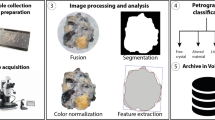Summary
Sieve tube “slime” is probably fibrillar as suggested by other workers. The granular material seen in electron micrographs of sieve tubes “fixed” with potassium permanganate is mostly a precipitate produced by the reaction of the permanganate with the sieve tube contents, particularly with sucrose, and with reagents used in the fixing, dehydrating and embedding process. Potassium permanganate is not therefore a good fixative for the electron microscopy of sieve tube contents. Neither is it suitable for the study of fine structure in vacuoles or vesicles containing precipitable solutes in other kinds of cells nor for examining the fine structure of their ground cytoplasm.
Similar content being viewed by others
References
Bradbury, S., and G. A. Meek: A study of potassium permanganate “fixation” for electron microscopy. Quart. J. micr. Sci. 101, 241–250 (1960).
Buvat, R.: Les infrastructures et la differenciation des cellules criblées de Cucurbita pepo L. Port. Acta biol. A 7, Nos 3–4, 249–299 (1963).
Dunn, A. E. G.: A mechanical drive for the Huxley microtome. Quart. J. micr. Sci. 104, 335–336 (1963).
Engleman, E. M.: Fine structure of the proteinaceous substance in sieve tubes. Planta (Berl.) 59, 420–426 (1963).
—: Sieve element of Impatiens sultanii. 1. Wound reaction. Ann. Bot. 29, 83–101 (1965).
—: Sieve element of Impatiens sultanii. 2. Developmental aspects. Ann. Bot. 29, 103–118 (1965).
Esau, K., and V. I. Cheadle: An evaluation of studies on ultrastructure of sieve plates. Proc. nat. Acad. Sci. (Wash.) 47, 1716–1726 (1961).
Eschrich, W.: Beziehungen zwischen dem Auftreten von Callose und der Feirstruktur des primären Phloems bei Cucurbita ficifolia. Planta (Berl.) 59, 243–261 (1963).
Evert, R. F., and L. Murmanis: Ultrastructure of the secondary phloem of Tilia americana. Amer. J. Bot. 52, 95–106 (1965).
Kollman, R.: On the fine structure of the sieve element protoplast. Phytomorphology 14, 247–264 (1964).
Luft, J. H.: Permanganate—a new fixative for electron microscopy. J. biophys. biochem. Cytol. 2, 799–802 (1956).
—: Improvements in epoxy resin embedding methods. J. biophys. biochem. Cytol. 9, 409–414 (1961).
Mehta, A. S., and D. C. Spanner: The fine structure of the sieve tubes of the petiole of Nymphoides peltatum (Gmel.) O. Kunze. Ann. Bot. 26, 291–299 (1962).
Author information
Authors and Affiliations
Rights and permissions
About this article
Cite this article
Johnson, R.P.C. Potassium permanganate fixative and the electron microscopy of sieve tube contents. Planta 68, 36–43 (1966). https://doi.org/10.1007/BF00385369
Received:
Issue Date:
DOI: https://doi.org/10.1007/BF00385369




